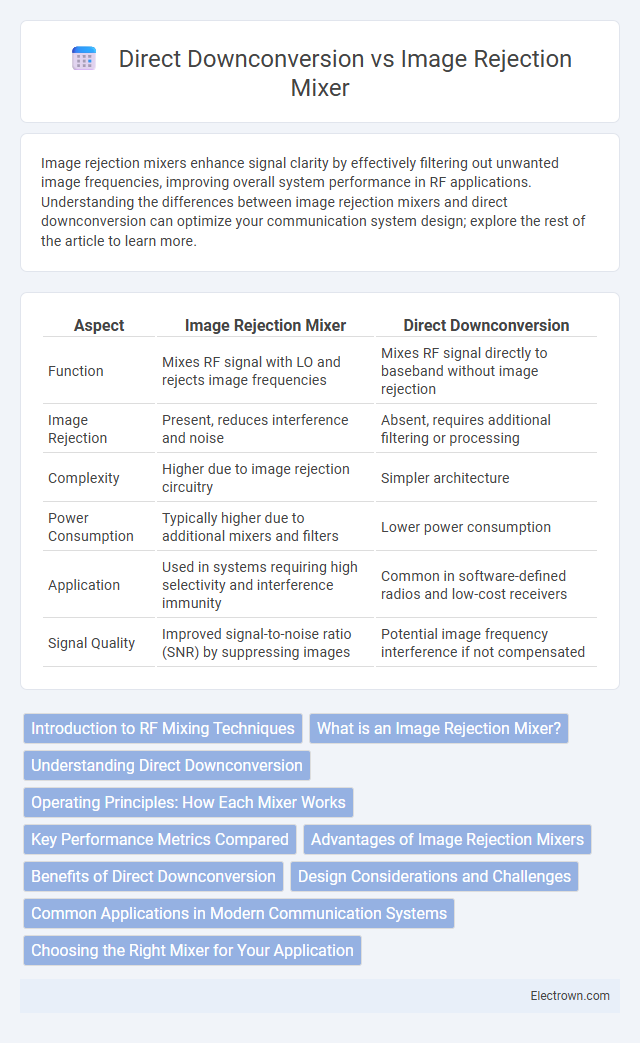Image rejection mixers enhance signal clarity by effectively filtering out unwanted image frequencies, improving overall system performance in RF applications. Understanding the differences between image rejection mixers and direct downconversion can optimize your communication system design; explore the rest of the article to learn more.
Table of Comparison
| Aspect | Image Rejection Mixer | Direct Downconversion |
|---|---|---|
| Function | Mixes RF signal with LO and rejects image frequencies | Mixes RF signal directly to baseband without image rejection |
| Image Rejection | Present, reduces interference and noise | Absent, requires additional filtering or processing |
| Complexity | Higher due to image rejection circuitry | Simpler architecture |
| Power Consumption | Typically higher due to additional mixers and filters | Lower power consumption |
| Application | Used in systems requiring high selectivity and interference immunity | Common in software-defined radios and low-cost receivers |
| Signal Quality | Improved signal-to-noise ratio (SNR) by suppressing images | Potential image frequency interference if not compensated |
Introduction to RF Mixing Techniques
RF mixing techniques are essential for converting radio frequency signals to intermediate frequencies or baseband signals. An Image Rejection Mixer improves signal quality by suppressing unwanted image frequencies, enhancing overall receiver performance in complex environments. Direct Downconversion simplifies the architecture by directly converting RF signals to baseband, minimizing components and reducing system noise.
What is an Image Rejection Mixer?
An Image Rejection Mixer is a key component in RF systems designed to eliminate unwanted image frequencies during frequency conversion, improving signal integrity and reducing interference. Unlike Direct Downconversion, which directly converts the RF signal to baseband and may require additional filtering, an Image Rejection Mixer inherently suppresses the image signal by using phase shifting and balanced mixing techniques. This ensures Your receiver efficiently focuses on the desired frequency while minimizing noise and distortion from image interference.
Understanding Direct Downconversion
Direct downconversion simplifies the receiver architecture by converting the radio frequency (RF) signal directly to baseband in a single mixing step, reducing the complexity and power consumption compared to an image rejection mixer. This technique eliminates the need for intermediate frequency stages and image filtering, enhancing integration for compact and low-cost RF front-ends. Your system benefits from improved sensitivity and reduced component count, making direct downconversion ideal for modern wireless communication applications.
Operating Principles: How Each Mixer Works
Image Rejection Mixers operate by combining signals with quadrature local oscillators and phase-shifted filters to cancel out unwanted image frequencies, effectively improving signal clarity and reducing noise. Direct Downconversion Mixers translate the input RF signal directly to baseband in a single step without separate IF stages, simplifying the architecture but requiring careful filtering to manage image frequency interference. Your choice depends on the need for image suppression versus system complexity and bandwidth requirements.
Key Performance Metrics Compared
Image rejection mixers achieve superior image frequency suppression, typically offering image rejection ratios above 30 dB, enhancing signal clarity in RF applications. Direct downconversion architectures simplify receiver design by eliminating intermediate frequency stages but often suffer from lower image rejection and higher susceptibility to DC offsets. Key performance metrics such as noise figure, linearity (IP3), and spurious response differ, with image rejection mixers generally providing better selectivity and reduced interference at the cost of increased circuit complexity.
Advantages of Image Rejection Mixers
Image rejection mixers offer superior signal quality by effectively suppressing unwanted image frequencies, which reduces interference and enhances overall receiver sensitivity. These mixers simplify front-end filtering requirements, allowing for more compact and cost-efficient designs in RF systems. Your communication system benefits from improved selectivity and reduced noise, leading to more accurate signal demodulation and performance.
Benefits of Direct Downconversion
Direct downconversion offers significant benefits including reduced system complexity by eliminating the image rejection mixer stage, resulting in lower power consumption and cost. It enhances signal fidelity through direct conversion from RF to baseband, minimizing phase noise and improving overall receiver sensitivity. This architecture supports compact designs and faster integration in modern communication systems such as software-defined radios and IoT devices.
Design Considerations and Challenges
Image rejection mixers require precise filter design and quadrature phase accuracy to effectively suppress image frequencies, posing significant complexity in achieving high isolation and linearity. Direct downconversion eliminates image frequency by converting RF signals directly to baseband, reducing the need for extensive filtering but increasing susceptibility to DC offsets and I/Q imbalance. Your choice depends on balancing these design challenges with system performance requirements like noise figure, linearity, and implementation complexity.
Common Applications in Modern Communication Systems
Image Rejection Mixers are commonly used in radio receivers and communication systems to effectively suppress unwanted image frequencies, enhancing signal integrity in complex modulation schemes like QAM and OFDM. Direct Downconversion, also known as zero-IF or homodyne, finds widespread application in software-defined radios (SDR) and cellular transceivers due to its simplified architecture and reduced component count. Both techniques play critical roles in modern wireless communication devices, balancing trade-offs between complexity, power consumption, and performance in 4G, 5G, and IoT applications.
Choosing the Right Mixer for Your Application
Selecting the appropriate mixer depends on the specific requirements of your RF system, with Image Rejection Mixers offering superior performance in reducing unwanted image signals and improving signal clarity. Direct Downconversion mixers simplify the signal chain by converting RF signals directly to baseband, making them ideal for applications where minimal latency and reduced component count are critical. Evaluate factors like image frequency interference, system linearity, and complexity to determine the optimal mixer choice for your communication or radar application.
Image Rejection Mixer vs Direct Downconversion Infographic

 electrown.com
electrown.com